|
< Earlier Kibitzing · PAGE 6 OF 6 ·
Later Kibitzing> |
Sep-28-19
 | | beatgiant: <doash>
It's a good point that on 60...Rf6 <61. a6?> fails because of 61...Rf3+ followed by 62...Rxf2+ etc.But if White avoids that blunder and instead replies 60...Rf6 <61. f4>, or 60...Rf6 <61. Kc3> Kc5 62. Kd3 (now threatening a6), I don't see how this differs a lot from the actual game line. Can you post your drawing idea in more detail? |
|
| Sep-28-19 | | doash: It's a shame that 60...Rf6! is never mentioned in any of the major commentaries, as this move puts up the greatest resistance. |
|
| Jun-15-20 | | pepechuy: Did Capablanca really play 44... Qf8?
It is a question, I am not implying it is a bad move.
In the book "From Steinitz to Fischer", by Euwe, the move given is 44... Qe8 |
|
| Sep-03-20 | | Gaito: In this critical position of the endgame (see diagram)

click for larger view
Capablanca played 38...Qa6 which looks logical, as it puts additional pressure on White's passed pawn. However, the move has the drawback of putting Black's queen too far away from the center. The strongest chess engine available in 2020 (Stockfish 10) suggests instead 38...Qf5! it seems that Black could have drawn the game after 38...Qf5! Using this powerful engine (computer vs. computer) with plenty of time to "think", let's review some sample variations:
I) 38....Qf5! 39. Qc3+ Kh7, and then:
A) 40. Rd2 Qb1+ 41. Kh2 Qb8+ 42. g3 Rxa4 43. Qf6 Qe8 44. Rd8 Ra6 45. Qd4 Ra4 46. Qf6 Ra6 47. Qxg6+ fxg6 48. Rxe8 Kg7 49. h4 Kf7 , this is a theoretical draw with correct play by both sides. B) 40. Re2 Rc5 41. Qb4 Qd5 42. Kh2 h5 43. Re3 Rc4 44. Qf8 Rf4 45. Re8 Qd4 46. f3 Qf6 47. Qg8+ Kh6 48. Qf8+ Kh7 49. Qg8+ Kh6 50. Qf8+ drawn position.
In the above variation (B), instead of 41...Qd5 Black could try also 41....Rc1+ 42. Kh2 Qf6 43. Qd2 Rb1 44. Qd5 Rf1, and then: B1) 45. a5 Qf4+ 46. g3 Rxf2+ 47. Rxf2 Qxf2+ 48. Qg2 Qa7 49. Qa2 f5 50. a6 h5 51. Kg2 h4 52. gxh4. Unclear, maybe a draw. B2) 45. Qc4 Qd6+ 46. g3 Qd7 47. Ra2 Re1 48. Qc3 Qd1 49. Qc6 Qd3 50. a5 Qf1 51. Qg2 Qc4 52. Ra3 Qa6 53. Ra2 Kg8 54. Qf3. Unclear, maybe equal and drawish. |
|
| Sep-03-20 | | Petrosianic: Have you checked the lines out and understand them to the point that you can explain why Black can hold the game? Or are you just taking Stockfish's word for it? For all you know, the strongest program of 2030 might not agree with this. |
|
Dec-07-20
 | | Tabanus: It's 44...Qe8 now. |
|
| Mar-25-21 | | Gaito: <Petrosianic> Yes, possibly in the year 2030 or 2040, there will be flying saucers and many weird things on our planet, and maybe also software good enough to tell us the truth in every chess position. For the time being, however, we must trust in what our available engines find out. It is the closest thing to the truth we have. |
|
| May-08-21 | | SymphonicKnight: The final and decisive game of the match. Kasparov -- "White's conduct of the technical stage of the game cannot be praised too highly." This game is really fun to go over with heavy computer analysis also. Both players find absolutely amazing moves. |
|
| May-09-21 | | aliejin: " is the closest thing to the truth we have."
The truth is what these two minds produced
, controlled by a clock,
in a game where they fought
for the world crown
The rest is binary masturbation |
|
May-09-21
 | | perfidious: <aliejin....The rest is binary masturbation> Of which you are a past master, on an analogous level to the two heavyweights who went at each other hard throughout this match. |
|
May-10-21
 | | Chessical: The Stockfish analysis uses the incorrect version of the score with 44...Qf8. The analysis now does not match the game score. If games have been corrected and already analysed, the correction process should include the computerised notation for the game. |
|
| Nov-23-21 | | SebasJT: Hello! You can watch a video of this chess game here: https://www.youtube.com/watch?v=gcx... |
|
| Mar-05-23 | | waddayaplay: You can play the ending after move 54 on lichess against a computer. Turns out it's really hard to win against perfect play (Capablanca didn't play the best moves either, unlike a computer). I wonder if even grandmasters would win. Black has many strategies to defend. |
|
Mar-05-23
 | | perfidious: <Petrosianic: Have you checked the lines out and understand them to the point that you can explain why Black can hold the game? Or are you just taking Stockfish's word for it? For all you know, the strongest program of 2030 might not agree with this.> If such an outstanding endgame player as Capablanca had his hands full in the face of his great adversary, what of we ordinary quite competent players who were nowhere near that class? |
|
| Jun-25-23 | | DanLanglois: The position after 10...Qxe7:

click for larger viewWhite's in fairly good shape. I might not suppose that lots of drama is going to come after this. Going forward to 20...h6, we see this:

click for larger viewI'm not terribly convinced by White's case, it seems like White's in good shape, as far as it goes. After 26. Qxb7:

click for larger viewIt's not an unmanageable situation. Black's move doesn't help, it's 26...Nc4? 
click for larger viewThis bad move allows shenanigans. Better is 26...Nd3. After 26...Nc4? White has 27. Rc1 or 27. Qb4 or even, 27. Ra1 or 27. a4. It seems that 27. Rc1 is much the best, though Alekhine played 27. Qb4. For an idea line, let's look at 27. Rc1:
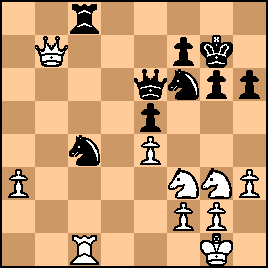
click for larger viewThis is bringing the rook in with gain of time -- Black has to scramble. 26...Nd6 27. Qb2 Rxc1+ 28. Qxc1: 
click for larger viewThis rook exchange just helps White. 28...Nc4 29. Nd2 Nxd2 30. Qxd2: 
click for larger viewThis knight exchange just helps White. Bringing this down to a simpler endgame is just bringing it down to an endgame that is more easily won for White. After, as Alekhine played, 27. Qb4, things are a bit cloudier. The game went 27...Ra8 and it's a double-attack on White's a-pawn, his passed pawn. 28. Ra1 and Black played 28...Qc6. Then, 29. a4 looks like this: 
click for larger viewNow maybe this is just as good for White, one might not complain about this. Here, Capablanca makes things even easier, by playing 29...Nxe4? Noting that 29...Ne8 is better. This move, though, the move 29...Nxe4? I mean, offers a knight exchange which is simplification which doesn't help Black to defend against White pushing his passed pawn. It's really over. Here is 29...Nxe4?:

click for larger viewAfter 29 moves it's really over? The game went 82 moves! Let's see if a mistake by White made this cloudy again. 30. Nxe5?:
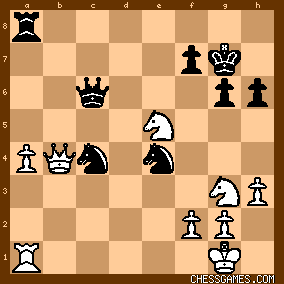
click for larger viewWay too clever, just exchange knights with 30. Nxe4! White got distracted, I suppose, by the idea of winning a pawn. So it goes. |
|
| Jun-25-23 | | DanLanglois: <woldsmandriffield: The move turning a difficult position into a lost one looks to be the nervous looking pawn grab 29..Nxe4. It is surprising Capablanca played this rather than the positional re-routing of his KN by 29..Ne8 (idea Nd6). Alekhine's reply 30 Nxe5 attracts praise on this thread and elsewhere but it is much less convincing than the simple 30 Nxe4 Qxe4 31 a5 Qd5 32 a6 and now 32..e4 just enables the White Knight to join the party (33 Qc3+ followed by Nd4).> Agreed.
This is 32. a6:

click for larger view |
|
| Jun-25-23 | | DanLanglois: <Gaito: ..Capablanca played 38...Qa6 which looks logical, as it puts additional pressure on White's passed pawn.> Sure, how bad can it be?
<However, the move has the drawback of putting Black's queen too far away from the center. The strongest chess engine available in 2020 (Stockfish 10) suggests instead 38...Qf5! it seems that Black could have drawn the game after 38...Qf5! Using this powerful engine (computer vs. computer) with plenty of time to "think", let's review some sample variations: I) 38....Qf5! 39. Qc3+ Kh7, and then:..> I'm intrigued by this idea that 38...Qf5 is Black's best shot for a draw. After 38. Qc7 we have this: 
click for larger view38...Qf5 39. Qc3+ Kh7 40. Kh2 h5 41. Qb4 Qe5+ looks like this: 
click for larger viewThe big picture here is we have a queen and rook endgame, there might be drawing chances, theoretically. After 38...Qa6, as in the game, Stockfish does claim that the situation is that much worse for Black. The game went 39. Qc3+ Kh7 40. Rd2 Qb6: 
click for larger viewHere, Alekhine played 41. Rd7, but Stockfish likes 41. Rb2(!): 
click for larger viewI'm not sure what the upshot is, if we look at Stockfish apparently improving on every other move, by some small degree. But I get the idea here that after 41...Rc5, we have a queen exchange, 42. Rxb6 Rxc3: 
click for larger viewNow our problem is only deciding about a rook endgame, whether it is won. And 43. a5 looks like this: 
click for larger viewSeems won? I am totally unsure about that -- even Stockfish doesn't somehow convert this to a win!? If we do this 'neither Alekhine nor Stockfish', then I wonder about 41. Rd4, on 'general principle': 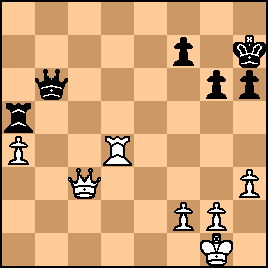
click for larger viewThis, where Alekhine played 41. Rd7. Point is, after 41. Rd4 Rf5 42. Qc2 Qf6 43. Rb4 Qa1+ 44. Rb1 Qd4 45. Qa2 Qa7 46. Rc1 h5: 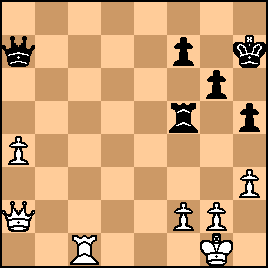
click for larger viewWhite has, I'm not sure. 47. h4 Re5 48. Rb1 Rc5 
click for larger viewI'm trying to 'play Stockfish' and I don't think I can make progress here. |
|
| Jun-25-23 | | DanLanglois: Alekhine won, so I wonder if we find another error from Capablanca. Going back to Alekhine's move of 41. Rd7 it looks like this:
click for larger viewCapablanca makes an error here. 41...Rf5 is better, double-attacking the f2-pawn. But Capablanca played 41...Qb1+?: 
click for larger viewMuch worse. 42. Kh2 Qb8+ 43. g3 Rf5 44. Qd4:
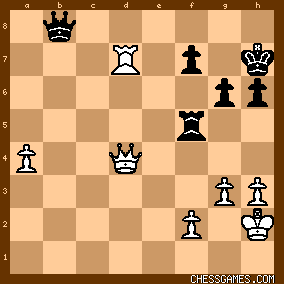
click for larger view44...Qe8 45. Rd5 Rf3:

click for larger viewAlekhine played 46. h4 -- the 'right' move. I mean, according to my engine. I don't think I could have guessed. 46. h4(!):
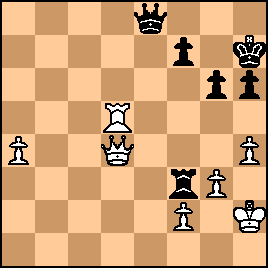
click for larger viewThis is not yet actual progress. By which I mean, if White were to play a5. But I can believe that it is coming. |
|
| Jun-25-23 | | DanLanglois: 46...Qh8 47. Qb6
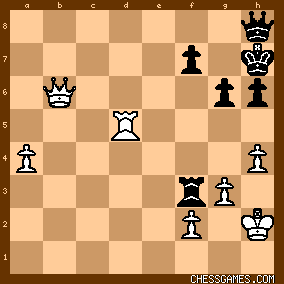
click for larger viewBlack offers a queen exchange, White doesn't go for it. This is much easier to win with the queens on the board, it seems. Next, Capablanca played 47... Qa1(?), my engine thinks this is not the best. Something like 47...h5 is to be preferred. 41...Qa1(?) looks like this: 
click for larger viewThen, 42. Kg2:

click for larger viewI think I'm getting the picture. |
|
| Jun-25-23 | | DanLanglois: If we roll along to 63. Ke5, it looks like this: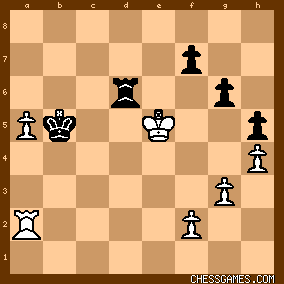
click for larger viewIt seems like Black can resign. |
|
Jun-25-23
 | | perfidious: <nad....much easier to win....> There was nothing at all easy about this ending, unless, of course, one had the 1927 version of Fishie sitting by one's side. |
|
Jun-25-23
 | | beatgiant: <DanLanglois> 30. Nxe4 might be an improvement, but it seems to require a very non-obvious line in case Black replies 30...Qxe4 31. a5 <Qd3>. 30. Qxe4 Nxe4 31. a5 Qd3 32. Rc1 <Ne3> 33. Qb7 Rxa5 34. Qb6 Ra3 35. <Qc5> 
click for larger viewIf this is the main line, I think it's asking a lot to expect Alekhine to calculate this sequence temporarily giving up pawns, correctly evaluate that White's threat of Qxe5+ and Rc8 is stronger than Black's counter-attack with Nxg2, and have sufficient confidence in the analysis to stake a crucial game in the world championship on it. |
|
| Jun-25-23 | | DanLanglois: <beatgiant: <DanLanglois> 30. Qxe4 Nxe4 31. a5 Qd3 32. Rc1 <Ne3> 33. Qb7 Rxa5 34. Qb6 Ra3 35. <Qc5>> 32...Ne3 gives this:
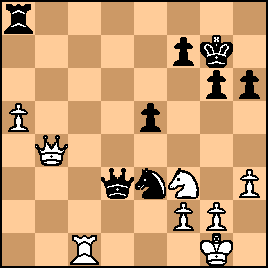
click for larger view<..it seems to require a very non-obvious line .. I think it's asking a lot to expect Alekhine to calculate this sequence temporarily giving up pawns, correctly evaluate that White's threat of Qxe5+ and Rc8 is stronger than Black's counter-attack with Nxg2> 33. Qb7 Rxa5:

click for larger viewWell, you have White giving up the a-pawn, but not because he has to stake a crucial game in the world championship on it. If we look at 32...Ne3 again: 
click for larger viewThere is your 33. Qb7 move here, or, similarly, White could move 33. Qb2, anticipating 33...Rxa5; White is just waiting while leaving that a5 pawn en prise as bait. This is rather flashy, but not necessary. Not even more brutal. Why not simply 33. Nxe5 now? 
click for larger viewAfter 33...Qd5, which sets up that threat you mention on g2 the White knight can return to where it was, 34. Nf3: 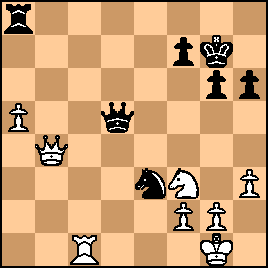
click for larger viewBlack's knight is under attack, so maybe 34...Nf5 here, and 35. Rc5: 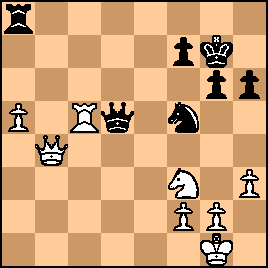
click for larger view ..an easy win. Of course this is neverthless very much concrete and specific, engine-assisted stuff. Figuring ideas out is harder in the endgame and applying them well is harder. |
|
Jun-25-23
 | | beatgiant: <DanLanglois> In the line you posted above, I wouldn't call it obvious to see your 33. Nxe5 allowing Black's ideal ...Qd5 but then reversing course with <34. Nf3>. I was surprised by the effectiveness of this forward-and-back maneuver. And although the final position in your line above has a higher engine eval than what White got in the game, it leaves more pieces on the board and lets Black approach White's camp and take some shots. For example (after 30. Nxe4 Qxe4 31. a5 Qd3 32. Rc1 Ne3 33. Nxe5 Qd5 34. Nf3 Nf5 35. Rc5 for your last diagram above, <an easy win>), White might then continue calculating 35...Qd1+ 36. Kh2 Qd6+ 37. g3 and now he has to look at several Black attacking tries, such as 37...h5. At move 30, White not only has to see all these tactics and more, but also correctly evaluate that Black's counterplay will fizzle out and yield an easier win for him than the slow and steady method he took in the actual game, again bearing in mind the importance of avoiding any slip-up at this stage in the match. So I remain of the opinion that, although 30. Nxe4 is objectively stronger, it wouldn't be an easy decision to make. |
|
| Feb-16-25 | | Ziryab: The position before White’s move 54 appears in Thomas Engqvist, <300 Most Important Chess Positions> (2018), except that Engqvist has both h-pawns on their starting squares. I spent the past 30 minutes playing it against Stockfish with multiple failures and take-backs. Eventually, I found my way to a Lucena Position. |
|
 |
 |
|
< Earlier Kibitzing · PAGE 6 OF 6 ·
Later Kibitzing> |
|
|
|





